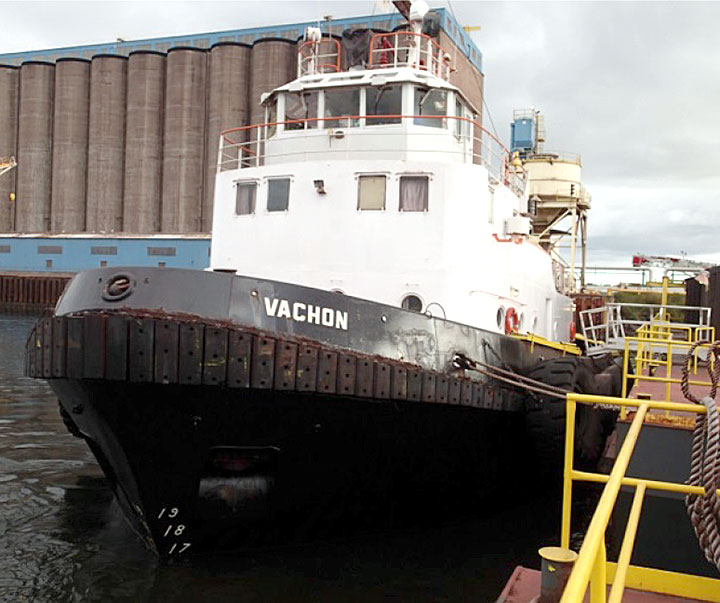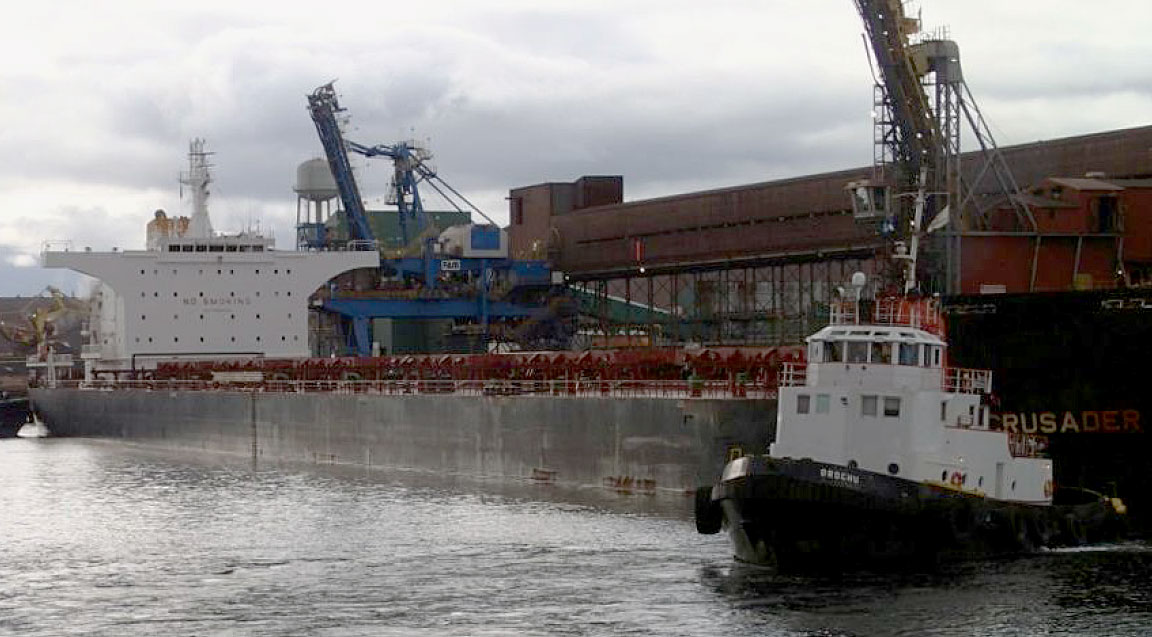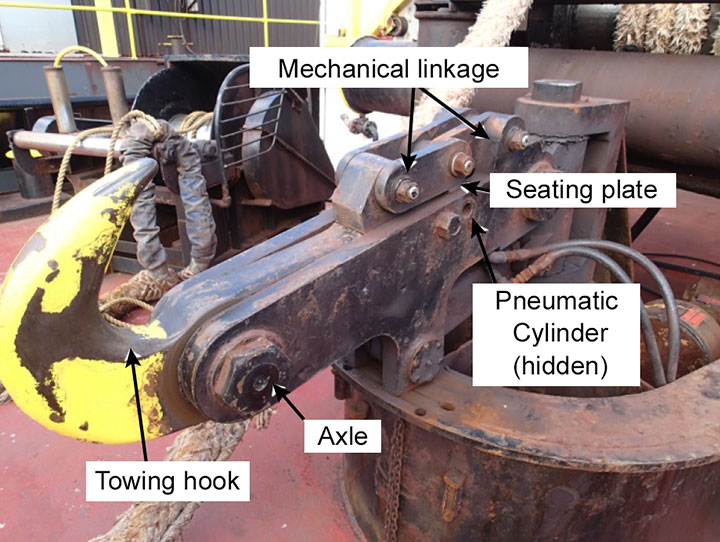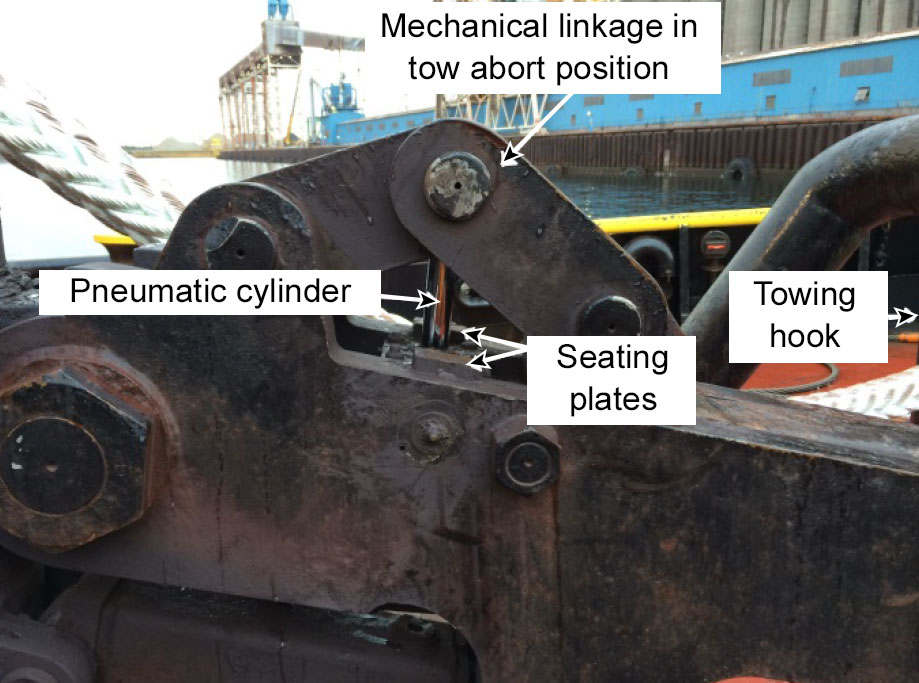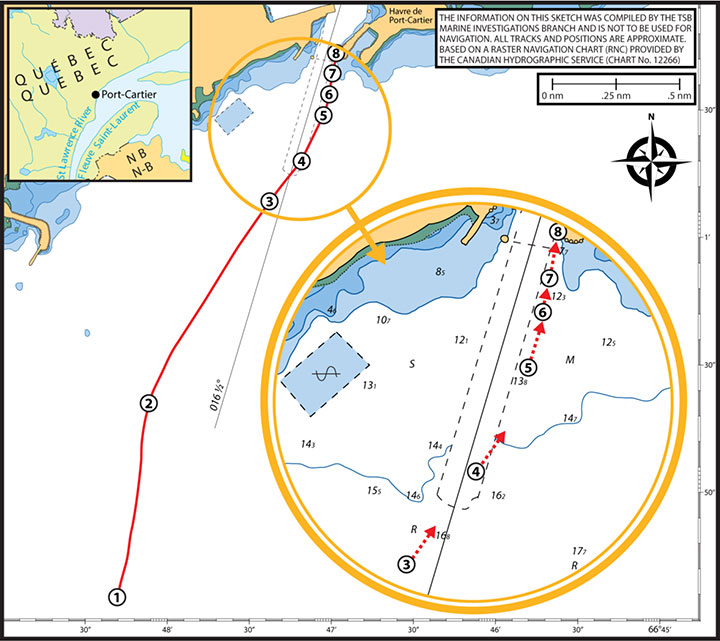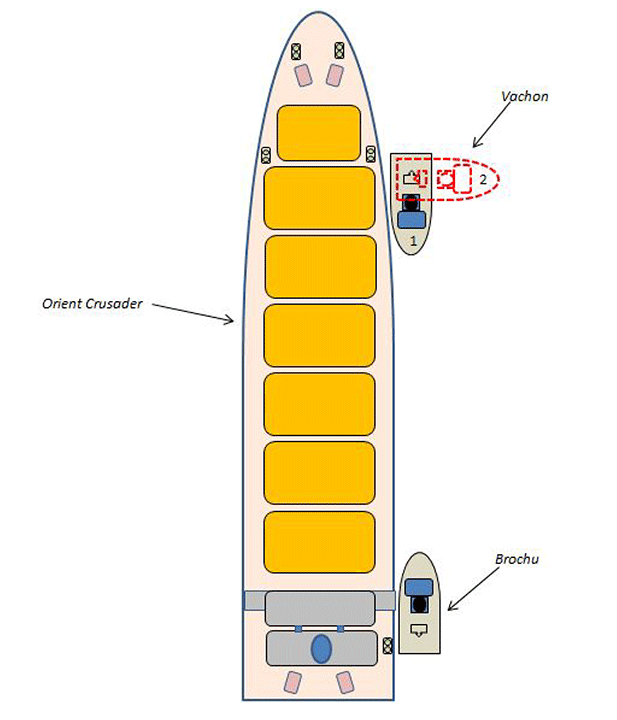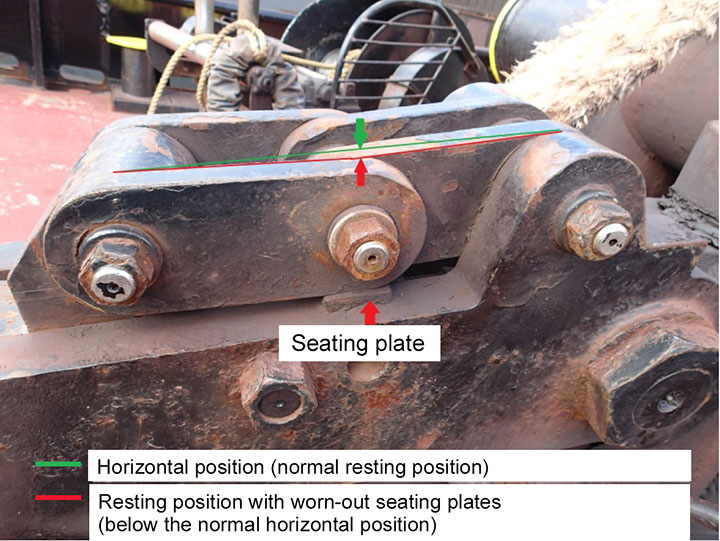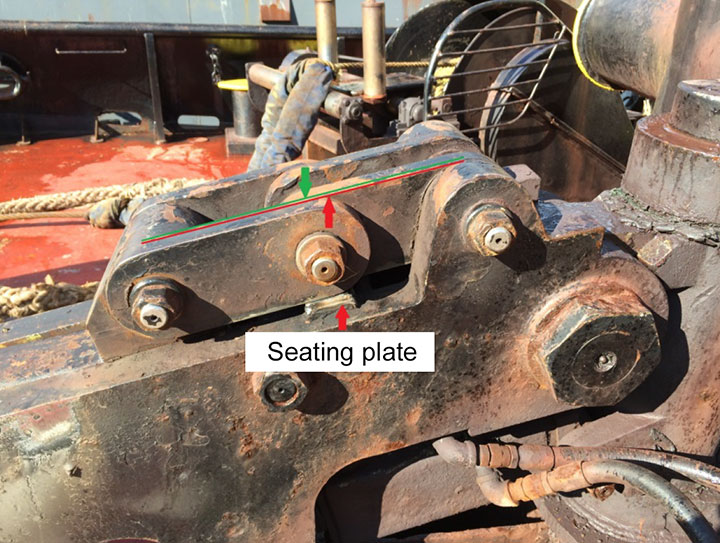Striking of the breakwater
Tug Vachon and bulk carrier Orient Crusader
Port-Cartier, Quebec
The Transportation Safety Board of Canada (TSB) investigated this occurrence for the purpose of advancing transportation safety. It is not the function of the Board to assign fault or determine civil or criminal liability. This report is not created for use in the context of legal, disciplinary or other proceedings. See Ownership and use of content. Masculine pronouns and position titles may be used to signify all genders to comply with the Canadian Transportation Accident Investigation and Safety Board Act (S.C. 1989, c. 3).
Summary
On 12 September 2014, at 2035 Eastern Daylight Time, the tug Vachon struck the breakwater in Port-Cartier, Quebec, while assisting the bulk carrier Orient Crusader to enter the harbour. The Vachon was secured to the Orient Crusader at the time, and there was insufficient sea room for the tug to clear the breakwater.No pollution or injuries were reported, but the Vachon and the breakwater sustained minor damage.
Factual information
Particulars of the vessels
| Name of vessel | Vachon | Orient Crusader |
|---|---|---|
| International Maritime Organization (IMO) number | 7305904 | 9464596 |
| Port of registry | Québec | Limassol |
| Flag | Canada | Cyprus |
| Type | Tug | Bulk carrier |
| Gross tonnage | 389.68 | 63 993 |
| Length | 30.45 m | 255.26 m |
| Breadth | 10.97 m | 42.99 m |
| Draft | Draft at build: Forward: 3.75 m Aft: 3.75 m |
Draft at the time of occurrence: Forward: 6.05 m Aft: 8.27 m |
| Built | 1973 | 2010 |
| Propulsion | 2 high-speed diesel engines driving 2 cycloidal drive propulsion systems | 1 slow-speed diesel engine driving a fixed-pitch propeller |
| Cargo | None | Ballast |
| Crew | 3 | 19 |
| Registered owners | ArcelorMittal Mines Canada Inc., Quebec, Canada | Orient Crusader Shipping Company Limited, Limassol, Cyprus |
| Managers | ArcelorMittal Mines Canada Inc., Quebec, Canada | Interorient Marine Services, Limassol, Cyprus |
Description of the vessels
The Vachon is a steel-hulled harbour tug with the superstructure and machinery spaces located amidships. The tug has 2 conning positions, one on the port side and one on the starboard side. The navigation equipment consists of 2 very high frequency (VHF) radiotelephones, an echo sounder, an electronic chart display, a radar, and a global positioning system (GPS). A towing winch equipped with a towing hook is located on the after deck and includes a tow-abort mechanism that is controlled from the bridge. The tug has a maximum bollard pull of 35 tonnes.
The Orient Crusader is a steel-hulled bulk carrier with 7 cargo holds and the superstructure and machinery spaces located aft. Bridge navigation equipment includes 2 radars, 2 GPSs, 2 echo sounders, and 3 VHF radiotelephones. The Orient Crusader is also fitted with a voyage data recorder (VDR).
Description of the port
Port-Cartier is a privately owned harbour that is owned and operated by ArcelorMittal Mines Canada Inc. (referred to hereafter as the company). The port consists of a 5-dock facility that is accessible year-round. The port's approach channel is dredged to a width of 122 m. At the harbour entrance, the channel is approximately 90 m wide between obstructions: a breakwater on the east side and 2 cribs located on the west side. The breakwater and the most southerly crib are each equipped with an entrance light. Private range lights mark the recommended inbound course of 16.5° true (T) (Appendix A).Footnote 1
Compulsory port services
Pilotage and the use of tugs are compulsory in the port. The company owns 2 tugs, the Vachon and the Brochu, to service the port. Pilotage is provided by 5 harbour pilots who work exclusively in this port and are employed by the company.
For vessels entering the port, the standard practice is for the pilot to position the vessel on the range lights when in proximity to the fairway buoy, which is located 1.6 nautical miles (nm) from the harbour. At this point, the tugs secure to the vessel, 1 forward and 1 aft. While entering the harbour, pilots normally keep the vessel's speed at approximately 3 knots to maintain control of the vessel, counteract the effects of the current, and avoid bank suction. The tugs are used to assist the vessel in entering the port and remain secured to the vessel until it is alongside.
History of the voyage
At 1907Footnote 2 on 12 September 2014, the Orient Crusader departed from its anchored position approximately 3 nm off Port-Cartier and began proceeding toward the port (Appendix A), where it was scheduled to dock at section No. 1.
At 2012, the Orient Crusader was approximately 0.28 nm northwest of the fairway buoy proceeding inbound when the Brochu transferred a pilot on board. The master and pilot conducted an exchange and the pilot reviewed the pilot card,Footnote 3 after which point the pilot took over the conduct of the vessel. At this time, the Orient Crusader's bridge team consisted of the master, the pilot, a third officer, and a helmsman. The third officer, who was officer of the watch (OOW), was at the engine telegraph, while the master was beside the pilot and repeating the pilot's orders to the OOW. The pilot was navigating visually to bring the vessel onto the ranges before entering the approach channel. He was also visually monitoring the 2 cribs on the west side and using the radar to assist with navigation.
After the Brochu had transferred the pilot on board, it passed a tow line up to the Orient Crusader and secured to the vessel's starboard quarter with its bow pointing in the same direction as the Orient Crusader. Shortly afterwards, at about 2024, the Vachon passed a tow line up and secured to thestarboard bow. The Vachon was positioned with its bow pointing toward the Orient Crusader's stern (Appendix B). At this time, the Vachon's crew consisted of the master, an engineer, and a seaman.
Once both tugs were secured, the Orient Crusader continued to proceed toward the port entrance. At 2027, the vessel was on a heading of 018°TFootnote 4 at a speed of 4 knots, but its course made good (CMG) was 035°T due to the effect of the prevailing current. The vessel's position was approximately 40 m east of the recommended track indicated by the range lights and the pilot was attempting to bring the vessel onto the range lights by altering course. By 2030, the vessel's heading was 005°T, its CMG was 019°T, and its speed was 3.7 knots. Its position was then approximately 90 m east of the recommended track, and outside the approach channel.
At approximately 2032, the pilot ordered the Vachon's master to “push 6”Footnote 5 to assist the vessel in returning to the recommended track. The pilot issued this order in French; subsequent communications with the 2 tug masters was also conducted in French. The Vachon's master manoeuvred the tug stern first and perpendicular to the Orient Crusader's starboard side. As the available sea room was diminishing and push 6 was not sufficient to return the vessel to its track, the master applied push 8, and then push 10.
By 2033, the bow of the Orient Crusader was abeam of the breakwater. The master on the Vachon advised the pilot that he might have to release the tow line because of the tug's proximity to the breakwater. When it became apparent that the Vachon would not clear the breakwater, the master repositioned the Vachon so that its bow was once again pointing toward the stern of the Orient Crusader. He then activated the tow-abort mechanism to release the tow line, which was under full tension, but the tow line did not release. At approximately 2035, the Vachon's port side struck the breakwater. Shortly after, the tension on the tow line decreased, allowing the tow line to release.
On the Orient Crusader, the pilot ordered astern propulsion to slow the vessel and swing the stern to port to allow the Brochu to clear the breakwater. The Vachon proceeded into the harbour, during which time the engineer checked for damage and the master repositioned the Vachon alongside the Orient Crusader. TheOrient Crusader passed another tow line to the Vachon when it came alongside. The Vachon and Brochu then both continued to assist with the docking manoeuvre. At 2200, the Orient Crusader was secured at section No. 1, and both tugs returned to their respective docks.
Damage to the vessels
The Vachon sustained some structural damage on the port side of the bridge that included a broken stay,Footnote 6 a shattered window, and a cracked door. The propeller guard and blades also incurred minor damage in the form of scratches and scuff marks.
Damage to the breakwater
The breakwater sustained minor damage to the infrastructure. One of the stays was broken and a beam protruding from the breakwater was bent.
Environmental conditions
On the night of the occurrence, the weather was clear and visibility was good. The wind was from the northwest at 5 to 10 knots. The air temperature was 10°C, and the sea temperature was 9°C. The spring tideFootnote 7 was ebbing, which resulted in a tidal current flowing in a southeasterly direction at 1.5 knots. On 12 September, there was a high tide of 3.1 m at 1652, followed by a low tide of 0.1 m at 2315. The strongest currents were estimated to occur at around 2000.
Vessel certification
The Vachon and the Orient Crusader were certified and equipped in accordance with existing regulations.
The Vachon was delegated to Lloyd's Register of Shipping (Lloyd's) in 2002 and was subject to annual and intermediate inspections by Lloyd's on behalf of Transport Canada (TC). As a vessel registered in the Delegated Statutory Inspection Program (DSIP),Footnote 8 it is also subject to compliance inspections by TC.
Personnel certification
The master of the Vachon held a Master Near Coastal certificate of competency issued in April 2012. Previously, he held a Master 500 Gross Tonnage, Near Coastal certificate which was issued in May 2010, and a Master, Ship of not more than 350 Tons or Tug certificate which was issued in April 2005. He had sailed as a master with the company since 2007 and had worked on tugs as master since 1998.
The master of the Orient Crusader held a Master Mariner certificate of competency issued in 2008. He had sailed in this capacity since 2010. This was his first time calling at the port of Port-Cartier.
The pilot held a Master Near Coastal certificate of competency first issued in September 2009 and renewed in August 2014. Prior to this, he held a Master, Intermediate Voyage CIV certificate that had been issued in September 2004. He had also completed bridge resource management (BRM) training in February 2004. He had served as a pilot in the port of Port-Cartier since 2008.
Master-pilot exchange
When a pilot embarks, the pilot and master normally conduct a master‑pilot exchange to help establish a shared mental model of the voyage. This exchange may include details such as intended courses and route, how manoeuvres will be carried out, the use of tugs, and bridge team roles and responsibilities, among other things. The master-pilot exchange forms the basis for the pilot and bridge team to work cooperatively to monitor the vessel's progress.
IMO Resolution A960 states that “masters and bridge officers have a duty to support the pilot and to ensure that his/her actions are monitored at all times” and that “the master, bridge officers and pilot share a responsibility for good communications and understanding of each other's role for the safe conduct of the vessel in pilotage waters.”Footnote 9
The obligations of the master and/or OOW when a pilot is on board are also clearly stated in the IMO's Standards of Training and Certification on Watchkeeping (STCW) 2010:
Despite the duties and obligations of pilots, their presence on board does not relieve the master or the officer in charge of the navigational watch from their duties and obligations for the safety of the ship. The master and the pilot shall exchange information regarding navigation procedures, local conditions and the ship's characteristics. The master and/or the officer in charge of the navigational watch shall co-operate closely with the pilot and maintain an accurate check on the ship's position and movement.Footnote 10
In 1995, the Transportation Safety Board of Canada (TSB) completed A Safety Study of the Operational Relationship between Ship Masters/Watchkeeping Officers and Marine Pilots. The objective of this study was to identify safety deficiencies associated with teamwork on the bridge, including communication between marine pilots and masters/OOWs. The report noted that a pilot's decision making “can become the weak link in a system prone to single-point failure; i.e., in the absence of effective monitoring, there is little safety backup for the pilot in the navigation of the vessel.”Footnote 11
Prior to boarding the Orient Crusader, the pilot spoke with the master by VHF radiotelephone and requested that the vessel be on a course of 035°T and be positioned west and abeam of the fairway buoy. When the pilot boarded, the master and pilot had a verbal exchange in which the manoeuvre and the use of the tugs were discussed. The master and the pilot reviewed the pilot card, and the master and the OOW signed the pilotage checklist. This checklist included items such as the roles and responsibilities of the bridge team and which of the vessel's crew members were responsible for monitoring its progress.
Towing winch
The towing winch on the Vachon is situated on the after deck on the centreline and is clearly visible from both the port and starboard conning positions. The winch consists of a drum on which the tow line is stored, 2 towing bollards, and a towing hook. During normal operations, the towing hook is used as the primary towing apparatus.
Tow-abort mechanism
A vessel with towing equipment whereby the tow line is attached to a hook is required to have a control that can be used to release the tow line from the hook immediately, as per section 136 of the Hull Construction Regulations. This is because towing operations can involve risks of sudden capsizing due to girding,Footnote 12 and collision or striking in areas with limited manoeuvring room. In these situations, the tow line may need to be released suddenly while at or near full tension.
The Vachon is fitted with a tow-abort mechanism for the towing hook that can be activated from either the port or the starboard conning position. The tow-abort mechanism is designed to function when the tow line is under tension. When the towing hook is in the working position, its mechanical linkage rests in a horizontal position on seating plates (Figure 1). When the tow-abort button at the conning position is pressed, compressed air is sent into a pneumatic cylinder that pushes the mechanical linkage upward and causes the towing hook to spin on its axle and release the tow line (Figure 2).
During routine towing operations, the tow-abort mechanism was used to release the tow line when it was under reduced tension.
Following the occurrence, the company examined the towing hook on the Vachon and observed that the seating plates for the mechanical linkage were recessed, causing the linkage to rest below its normal horizontal position (Appendix C). The TSB conducted a release test to determine at what point the tow-abort mechanism functioned. The test determined that the mechanism only operated when the applied tension was approximately 10 tonnes or less. TC and the company subsequently conducted a release test on the Brochu, with the same results.
The investigation could not determine at what point in time the tow-abort mechanism had ceased to function when the applied tension in the tow line was greater than 10 tonnes.
Company maintenance
According to the Canada Shipping Act, 2001 (CSA 2001), the authorized representative (AR) of a Canadian vessel shall “ensure that the vessel and its machinery and equipment meet the requirements of the regulations.”Footnote 13. Section 106 of the CSA 2001 specifies that vessel operators shall develop procedures for the safe operation of the vessel and for dealing with emergencies. Compliance with section 106 is verified during vessel certification inspections.
The company has a maintenance program for the Vachon and the Brochu that uses a software program called IVARA. This program generates a monthly printout of maintenance tasks, which are based on the manufacturer's recommended maintenance intervals for specific items. The practice was for the chief engineer to use the printout as a basis for assigning maintenance tasks.
The company's maintenance program included an item for the towing winch to be greased on a monthly basis. The program did not include regular inspection of the tow-abort mechanism, nor were there any records indicating that it had been tested under maximum allowable load.
Regulatory inspections
Prior to the occurrence, the Vachon was last inspected and certified on 16 April 2014. As part of this inspection, the Lloyd's surveyor performed a visual inspection of the deck equipment, including the towing equipment. When conducting annual inspections, the Lloyd's surveyors use a checklist generated by Lloyd's Class Direct system. This checklist provides guidance for the inspection of items such as the hull, machinery and controls, and various types of equipment (e.g. emergency, deck, firefighting, and lifesaving). The checklist does not include guidance for the inspection of towing equipment (e.g. hooks, winches, or tow-abort mechanisms), as the Class Direct system does not contain this information.
In addition to the annual inspections by Lloyd's, TC conducts compliance inspections approximately every 5 years to monitor the work that is done during Lloyd's inspections. If any anomalies are found, the TC inspector will note them and may conduct a more comprehensive inspection.
The most recent compliance inspection, conducted in 2009, did not identify any anomalies related to Lloyd's inspection of the towing equipment. The Vachon was due for its next compliance inspection in 2014, but this had not yet been conducted at the time of the occurrence.
Delegated Statutory Inspection Program
When the company applied to enroll the Vachon in the DSIP, TC conducted a study of the discrepancies between Lloyd's rules and Canadian regulations with respect to the vessel (referred to as a gap analysis). This gap analysis was provided to Lloyd's so that its inspection procedures could be amended to cover all applicable Canadian regulations. The gap analysis identified a number of items with respect to the towing equipment, including the requirement under section 136 of the Hull Construction Regulations for the vessel to have a control that can be used to release the tow line from the hook immediately.
Following the gap analysis, a handover inspection of the Vachon was jointly conducted by Lloyd's and TC. The records from this inspection indicate that the towing equipment had been verified and found to be in compliance with all applicable regulations. The investigation could not determine how the towing equipment was verified.
After this process was completed, the Vachon was officially delegated to Lloyd's.
Safety management
The principal objectives of safety management on board vessels are to ensure safety at sea, prevent human injury or loss of life, and avoid damage to the environment. Ideally, to manage safety, a vessel operator would identify existing and potential risks, establish safety policies and procedures to mitigate the risks, and then provide a means to continuously gauge effectiveness so as to improve organizational safety where necessary. A documented, systematic approach to safety management (known as a safety management system, or SMS) helps ensure that individuals at all levels of an organization have the information and the tools needed to make sound decisions in both routine and emergency operations.
The company had ISO certification to manage the risks involved in activities such as working aloft, hot work, and working in enclosed spaces, but it did not have an SMS for its vessels, nor was one required by the current regulations. TC's proposed amendments to the Safety Management Regulations would require an SMS on vessels 24 m or greater in length, which would include the Vachon.
Voyage data recorder
In addition to bridge audio, a VDR continuously records data such as the time, vessel heading and speed, gyrocompass, alarms, VHF radiotelephone communications, radar, echo sounder, wind speed and direction, and rudder/engine orders and responses. The VDR's save button must be activated following an occurrence in order for the data to be retrievable. IMO guidelines state that the owner must be responsible, through on-board standing orders, for ensuring that this evidence is preserved in a timely manner because an investigator is very unlikely to be in a position to instigate this action soon enough after an accident.Footnote 14
The VDR on theOrient Crusader had a playback memory capacity of 12 hours. Following the occurrence, the VDR data could not be retrieved because the save button was not activated within 12 hours following the occurrence. The Orient Crusader's contingency plan included steps to follow in the event of a collision, one of which was to activate the VDR to save the data.
Previous occurrences
Previous TSB investigations have identified issues related to a lack of monitoring by bridge teams when a pilot is on board the vessel, and inadequate communications between the pilot and the bridge team.
In August 2013, the bulk carrier Heloise and the tug Ocean Georgie Bain collided while transiting the St. Lawrence River in the Port of Montréal, Quebec. The TSB investigation into this occurrenceFootnote 15 found that the pilot on the Heloise was not monitoring the Ocean Georgie Bain's position at the time of the collision, and the bridge crew on the Heloise had not been assisting the pilot by maintaining a lookout or using navigational equipment to advise the pilot of relevant traffic. The lack of monitoring by the pilot and bridge team contributed to the collision between the 2 vessels.
In November 2012, the bulk carrier Tundra, transiting downbound in the St. Lawrence River, exited the navigation channel and ran aground off Sainte-Anne-de-Sorel, Quebec. The TSB investigation into this occurrenceFootnote 16 found that the pilot and other members of the bridge team had not been exchanging information pertaining to the navigation of the vessel. The Board also found that if bridge team members do not share a complete and common understanding of a vessel's intended route and continuously exchange information, their ability to monitor a vessel's progress may be compromised.
TSB Watchlist
Safety management and oversight is a 2014 Watchlist issue
The Watchlist is a list of issues posing the greatest risk to Canada's transportation system; the TSB publishes it to focus the attention of industry and regulators on the problems that need addressing today.
The TSB has identified safety management and oversight as a Watchlist issue, noting that some transportation companies are not effectively managing their safety risks, and TC oversight and intervention has not always proven effective at changing companies' unsafe operating practices.
Analysis
Events leading to the striking of the breakwater
After the pilot boarded the OceanCrusader, the pilot and the master exchanged information about the upcoming manoeuvre to dock the vessel. This exchange did not include the effect of the ebbing tide on the current, which was setting easterly and was stronger than normal due to the spring tides, nor did it address the responsibility of the bridge team to monitor the vessel's approach.
After taking over the con, the pilot navigated primarily by using visual cues to align the vessel on the recommended track, which was indicated by range lights. The pilot also visually referenced the cribs at the entrance to the harbour. Shortly after the tugs made fast, with the Vachon secured forward and the Brochu aft, the vessels advanced toward the harbour entrance, but were set east of the recommended track by the influence of the tidal current.
The pilot was aware of the ebbing tide and attempted to counteract it through course alterations and the use of the forward tug. However, the pilot did not fully appreciate the strength of the current and, therefore, the corrective actions were inadequate. As well, the monitoring by the Orient Crusader's bridge team did not identify the developing unsafe situation with respect to the Vachon's proximity to the breakwater.
When it became apparent that the Vachon would not clear the breakwater, the tug master activated the tow-abort mechanism in order to release the tow line and take evasive action to avoid striking the breakwater. However, the tow line did not release while under full tension. Moments later, the Vachon struck the breakwater. The tension on the tow line subsequently decreased, allowing the tow line to release. The Orient Crusader was eventually docked with the assistance of the 2 tugs.
Cause of tow-abort mechanism failure
The crew of the Vachon regularly used the tow-abort mechanism to release the tow line when it was under reduced tension, which gave the impression that the tow-abort mechanism was functioning properly. However, under the repeated pounding of the mechanical linkage, the seating plates had become recessed. At the time of the occurrence, the linkage was resting below its normal horizontal position. This meant that the pneumatic cylinder was unable to push the mechanical linkage upward in order to release the tow hook when the tow line was under full tension.
Inspecting and testing of tow-abort mechanisms
Given the risks of girding and capsizing posed by towing operations, tugs must have a reliable means by which to immediately abort a tow, regardless of the degree of tension placed on the tow line. Regular testing of the tow-abort mechanism by the company and consistent inspections by the regulator are ways to verify that this safety-critical equipment is operating properly.
Although the crew on the Vachon used the tow-abort mechanism on a daily basis to release the tow line when it was under reduced tension, the company maintenance program did not include regular testing to verify that the mechanism was fully operational. Furthermore, Lloyd's Register of Shipping (Lloyd's) surveyors were not consistently inspecting it because their Class Direct system contains no guidance for inspecting towing equipment on harbour tugs. This lack of guidance originated with the Delegated Statutory Inspection Program (DSIP), when Transport Canada (TC) inspection criteria for towing equipment were not incorporated into Lloyd's inspection procedures. Over the years, TC compliance inspections of harbour tugs did not identify this omission. As a result, each Lloyd's surveyor was left to individually decide whether to inspect a harbour tug's towing equipment and how this would be done, limiting the effectiveness of these inspections with regard to identifying and tracking potential problems.
In the case of the Vachon, the company was not regularly testing the tow-abort mechanism to ensure it was fully operational and Lloyd's was not consistently inspecting the towing equipment, reducing the opportunities for both parties to identify potential problems with the tow-abort mechanism.
If vessel operators are not testing towing equipment, and regulators are not consistently inspecting it, there is a risk that problems will go unnoticed and the equipment will not function in an emergency situation.
Safety management
Effective safety management requires large and small organizations to be cognizant of the risks involved in their operations, to manage those risks competently, and to be committed to operating safely. A safety management system (SMS) is a documented, systematic approach to ensure safe practices in vessel operations and to promote a safe working environment. It requires the establishment of safeguards against all identified risks and continuous improvement of the safety management skills of personnel ashore and on board vessels. SMS must be tailored to the needs of the operation.
Currently, TC does not have regulations mandating the implementation of an SMS on a vessel such as the Vachon. Although it is the operator's commitment that forms the cornerstone of safety management, regulatory frameworks do provide motivation and valuable guidance in the development and implementation of an SMS.
In this occurrence, the company did not have a formal process for managing risk with respect to the operation of the tugs. Therefore, potential hazards associated with the towing equipment (e.g. absence of testing and inspection procedures, routine use of tow-abort mechanism) had not been assessed.
If vessel operators do not have a formal process for managing safety, there is an increased risk that hazards will not be identified and risks effectively mitigated.
Responsibilities for vessel monitoring
When a vessel is under pilotage, the pilot, the master, and the bridge personnel must all be clear about their respective responsibilities relating to the safe passage of the vessel. An effective master-pilot exchange is an opportune time for these responsibilities to be defined and can help ensure that the bridge team takes an active role in monitoring the vessel's progress and identifying potential unsafe situations.
In this occurrence, the pilot did not fully appreciate the extent to which the vessel was being set off course by the current, and the bridge team was not providing safety backup with respect to the navigation of the vessel. The third officer, who was also the officer of the watch (OOW), was at the engine telegraph, while the master was standing next to the pilot and conveying helm and engine orders. Other than the pilot, it was unclear as to who was monitoring the vessel's position. It is therefore likely that the master and the OOW were not aware of the extent to which the vessels had deviated from the recommended track and were not in a position to assist the pilot in determining whether the course alterations were effective.
Previous investigations by the Transportation Safety Board of Canada (TSB) have identified similar issues with respect to a lack of monitoring by bridge team members when a pilot is on board, thereby creating an opportunity for single-point failure to occur. For example, in the occurrence involving the Heloise and the Ocean Georgie Bain, Footnote 17 the bridge team on the Heloise was not actively assisting the pilot during the voyage by monitoring the Ocean Georgie Bain's positionor maintaining a lookout. The pilot essentially assumed all navigational responsibilities, including that of lookout, increasing his mental workload and contributing to the eventual collision of the Heloise with the Ocean Georgie Bain. In the occurrence involving the Tundra, Footnote 18 the pilot did not use all available resources to safely navigate the vessel, and the monitoring by the OOW was ineffective, which contributed to the eventual grounding of the vessel.
If bridge team members do not continue to actively participate in the monitoring of the vessel's progress when a pilot is on board, there is a risk that errors in navigation will go undetected.
Voyage data recorder
The purpose of a voyage data recorder (VDR) is to create and maintain a secure, retrievable record of information indicating the position, movement, physical status, and command and conduct of a vessel for the period covering a minimum of the last 12 hours of operation. Objective data are very helpful for accident investigators seeking to understand the sequence of events, identify operational problems, and investigate human factors issues.
The VDR data on the Orient Crusader could not be retrieved because the save button was not pressed within the 12 hours following the occurrence. The crew did not press the button because the Orient Crusader was not the primary vessel involved in the occurrence and it did not sustain any damage.
If VDR data are not available to an investigation, this may preclude the identification and communication of safety deficiencies to advance transportation safety.
Findings
Findings as to causes and contributing factors
- The Orient Crusader, while being assisted by 2 tugs, deviated from the recommended track under the effect of the prevailing current.
- The pilot did not fully appreciate the extent to which the current was setting the vessel to the east and corrective actions were not effective in returning the vessel to the recommended track.
- Monitoring by the Orient Crusader's bridge team did not identify the developing unsafe situation with respect to the Vachon's proximity to the breakwater.
- The tug master on the Vachon activated the tow-abort mechanism to release the tow line and take evasive action; however, the mechanism failed to operate and the tug struck the breakwater.
Findings as to risk
- If vessel operators are not testing towing equipment, and regulators are not consistently inspecting it, there is a risk that problems will go unnoticed and the equipment will not function in an emergency situation.
- If vessel operators do not have a formal process for managing safety, there is an increased risk that hazards will not be identified and risks effectively mitigated.
- If bridge team members do not continue to actively participate in the monitoring of the vessel's progress when a pilot is on board, there is a risk that errors in navigation may go undetected.
- If voyage data recorder data are not available to an investigation, this may preclude the identification and communication of safety deficiencies to advance transportation safety.
Other findings
- During the delegation process, Transport Canada's inspection criteria for towing equipment were not incorporated into Lloyd's Register of Shipping inspection procedures, and this omission went undetected.
- It was the practice on board the Vachon to use the tow-abort mechanism to release the tow line during routine towing operations.
- While manoeuvring the vessel, the pilot was communicating with the 2 tug masters in French.
Safety action
Safety action taken
Transport Canada
On 13 November 2015, Transport Canada (TC) issued FLAGSTATENET 11-2015, “Inspection: Emergency Release Equipment on Tug,” which was sent to all TC inspectors and Recognized Organization surveyors reminding them of the regulatory requirements concerning tow-abort equipment. More specifically, inspectors and surveyors were instructed to verify the following items at each statutory or monitoring inspection and surveys:
- Verify that the tug is fitted with both the remote controls to reduce the vessels power and if proper communication between the tow winch control stations and any conning positions; and
- Verify the proper functioning of the tow-abort equipment at full power (this could be emergency release of the hook or with the release of the gear when using a winch).
As well, if the authorized representative does an emergency release test on the tow-abort equipment at full power prior to the inspection or survey, the inspector or surveyor is required to verify that the official logbook or operational log contains the entry reporting this test. The inspector or surveyor must also to verify that all maintenance of these emergency release systems is properly logged.Footnote 19
Lloyd's Register of Shipping
Lloyd's Register of Shipping has added a question to its annual and intermediate inspection checklists that requires surveyors to examine the emergency release arrangements for the towing hook and check for operability as far as practicable.
ArcelorMittal Mines Canada Inc.
Following the occurrence, the company added an item to its monthly security inspection report requiring a hook test under tension to be undertaken every 3 months on the tugs.
Interorient Marine Services Ltd.
Following the occurrence, Interorient Marine Services Ltd. issued a Navigation Item to all of the vessels in its fleet requiring all bridge team members to review Chapter 3 of their Safe Navigation Manual (Pilotage). The Navigation Item also included a reminder to all masters to ensure that the bridge is properly manned.
On 11 September 2015, the master of the Orient Crusader conducted a second navigational assessment to identify any deficiencies. On 03 April 2015, the company started to conduct external navigational assessments on its vessels and this is ongoing.
The Safe Navigation Manual and Vessel Contingency Plans have been amended to mandate the saving of the voyage data recorder (VDR) information for any type of incident.
This report concludes the Transportation Safety Board's investigation into this occurrence. The Board authorized the release of this report on . It was officially released on .
Appendices
Appendix A – Area of occurrence
| No. | Time | Event | Heading | Course made good | Speed |
|---|---|---|---|---|---|
| 1 | 2000 | Orient Crusader proceeds inbound | 358°T | 15.6°T | 3.7 knots |
| 2 | 2012 | Pilot boards Orient Crusader | 021°T | 13.9°T | 4.6 knots |
| 3 | 2024 | Vachon and Brochu are secured to Orient Crusader | 032°T | 35.8°T | 3.9 knots |
| 4 | 2027 | Orient Crusader approaching eastern limit of approach channel | 018°T | 35.0°T | 4.0 knots |
| 5 | 2030 | Orient Crusader east of approach channel limit | 005°T | 19.0°T | 3.7 knots |
| 6 | 2032 | Vachon begins to push | 004°T | 9.4°T | 3.4 knots |
| 7 | 2033 | Orient Crusader's bow is abeam of the breakwater | 001°T | 10.8°T | 3.0 knots |
| 8 | 2035 | Vachon strikes the breakwater | 009°T | 333.1°T | 1.2 knots |
Appendix B – Position of tugs relative to vessel
| Time | Position of Vachon |
|---|---|
| 2024 | Position 1 |
| 2032 | Position 2 |
| 2033 | Position 1 |
